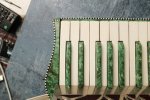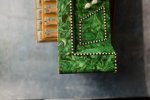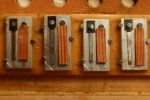Hi,
I’m in the midst of repairing an old Casali Verona accordion. I’ve update the bass mechanism, replaced valves etc but am realising that the reeds are of a very poor quality and will need substantial work to get them playing again properly. I have a salvaged Excellsior which has really nice reeds so was thinking of swapping them over. They metal reeds are almost the same size.
Can anyone tell me if this should be fairly straight forward of if there’s anything I need to watch out for??
Also, any tips on making the keyboard smoother apart from replacing valves/pallets and replacing felt under it??
Thanks!
N
I’m in the midst of repairing an old Casali Verona accordion. I’ve update the bass mechanism, replaced valves etc but am realising that the reeds are of a very poor quality and will need substantial work to get them playing again properly. I have a salvaged Excellsior which has really nice reeds so was thinking of swapping them over. They metal reeds are almost the same size.
Can anyone tell me if this should be fairly straight forward of if there’s anything I need to watch out for??
Also, any tips on making the keyboard smoother apart from replacing valves/pallets and replacing felt under it??
Thanks!
N





